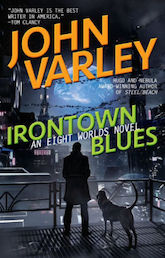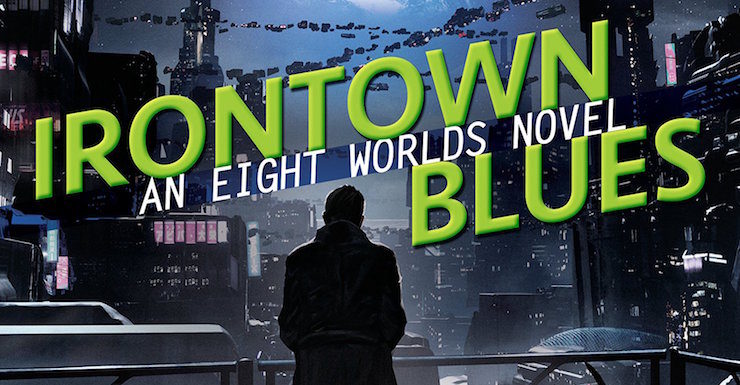John Varley’s Irontown Blues is the third volume in a loosely connected trilogy set in one version of his Eight Worlds . The first two books of the series are 1992’s Steel Beach and 1998’s The Golden Globe. In the years since The Golden Globe saw print, Varley has published one full quartet of novels, plus two standalone novels and at least three short stories . There was, however, no appearance of the promised Irontown Blues, which led a few readers to mutter darkly . In the meantime, one author was inspired to try his hand at an Eight Worlds-style story; have fun guessing who.
Now, the long wait is over.
Before the Big Glitch, Christopher Bach was a cop. The Big Glitch turned Bach into a traumatized survivor. No longer a full-fledged policeman, he fills his time playing at being a detective in the Philip Marlowe mold. There isn’t much call for a detective on the Moon, even a detective with a cybernetically enhanced dog like Sherlock.
Enter client Mary Smith. She spins a sad tale of a foolish assignation that left her the victim of an engineered STD, para-leprosy. Happily, Eight Worlds medicine is very, very good, and Ms. Smith will get her cure. She’d also like to track down the man who deliberately infected her.
A moniker like “Mary Smith” is a great big red flag hinting that perhaps Mary Smith is not entirely on the up and up. If there’s one truth every tough detective knows, it’s “don’t trust a client unless you want to end up like Miles Archer.”

Before he tracks down the alleged miscreant, Bach sets out to find out just who Ms. Smith might be.
Bach isn’t a policeman anymore, but he still knows how to access the CCTV network. The Moon’s near ubiquitous CCTV coverage is almost impossible for the unskilled to evade. Mary Smith seems peculiarly conscious of the CCTV cameras. The fact that she manages to give Bach the slip without his being immediately aware of the fact hints at an interesting skill set.
Who is Mary Smith? Why the subterfuge? What is her true purpose in engaging Bach’s services? All questions Bach wants to answer. All questions he needs to answer if he hopes to survive the next few days…
It might seem a bit odd that Bach focuses on the noir fiction of the early 20th century. A Doylist might speculate that this reflects an odd cultural disconnect between SF writers of a certain vintage and popular culture; something similar can be seen in 2011’s The Moon Maze Game, which is set in a 2085 where most of the big names in SF referenced are ones fans of 1985 would recognize. For that matter, of the five named individuals in the book’s “Praise for John Varley” section, two are dead (one for twenty-three years), and the quotations from newspapers and magazines seem to be…of vintage stock.
The Watsonian explanation might be that centuries after getting booted off Earth, the Eight Worlds culture in general is still pretty traumatized by the Invasion and thus places a lot of weight on those shreds of pre-Invasion Culture that survived the catastrophe. A second Watsonian explanation is that Bach was traumatized by the Big Glitch (how, exactly, the book explains in detail), and copes by escaping into a fantasy world where all a guy needs to prevail are good intentions, determination, and a line of snappy patter.
Buy the Book


Irontown Blues
Irontown Blues’ plot, themes and tone are much closer to the Thunder and Lightning books than the original Eight Worlds stories. Gone is the Ophiuchi Hotline, source of so much interesting alien technology provided for reasons unexplained until the eponymous novel. Instead, there’s V. M. Smith (introduced in Steel Beach), a brilliant inventor much like Red Lightning’s Jubal Broussard or Heinlein’s Slipstick Libby. Rather than a world transformed by ubiquitous null-suits and other wonders, such treasures are the monopoly of a few. One could draw a thematic line right from Steel Beach through the Thunder and Lightning books to Irontown Blues. The thematic connection between the classic Eight Worlds and the version that was revealed in Steel Beach is less concrete.
Considered as an Eight Worlds, Mark II novel: this is the volume that provides the connections that transform the first two books, 1992’s Steel Beach and 1998’s The Golden Globe, into the first two thirds of a trilogy, rather than books that just happen to share a time and place. At the same time, Varley is old school enough that Irontown Blues functions as a standalone; readers do not need to track down the first two books to follow the plot in this one.
Considered as a detective novel…the problem isn’t that Bach is terrible at his job. He unravels the clues quickly enough. If he is not as careful as he should be, neither were his role models. It’s more that Smith and her compatriots have chosen a pretty baroque path to their goals for reasons that, when explained, were not as convincing to this reader as they could have been. Granting that the faction in question has already been established as a conclave of eccentrics, surely there was a better way?
But at least there’s Sherlock, smarter than his owner credits and even more determined than Bach. Bach may be but a pawn in a deadly game, but his faithful dog is at least a knight.
1: As previously discussed, the Eight Worlds was one of Varley’s two main settings in the 1970s (the other being the Anna-Louise Bach stories ). Set long after alien invaders took the Earth for their own, the Eight Worlds stories were set in an era of comparative peace and prosperity. In this version of the Eight Worlds, large scale conflict was unknown (if only because nobody wanted the Invaders to notice humans a second time), the Gini Coefficient was low, and technology allowed most people to live the lives they wanted.
Eight Worlds, version one, began with 1974’s Picnic on Nearside and ended with 1980’s Beatnik Bayou. Between 1980 and 1992, Varley focused on other projects and other settings. When he came back to the Eight Worlds, he included a disclaimer warning readers he wasn’t going to bind himself to previously established chronology. Readers of the happy-go-lucky sort won’t be bothered by the inconsistencies between the Eight Worlds as they were depicted in the 1980s. Other readers, inexplicably determined to invest more effort into caring about continuity than was invested by the stories’ author, may want to think of the Metal Trilogy as its own setting, one that has many elements in common with the original Eight Worlds.
2: I mention the short stories to draw attention to a custom of Varley’s I wish more authors of short works would emulate. Currently, most of Varley’s short works can be found in one or the other of two collections, The John Varley Reader and Goodbye, Robinson Crusoe and Other Stories. There is no overlap. In fact, Varley has always been extraordinarily conscientious about not making readers pay twice for the same story, unlike, say, Keith Laumer, whose Disco-Era collections often had considerable overlap.
3: Some bookish fans mutter endlessly about series whose instalments come out all too infrequently. Not that I am such a person but other people—terrible people, no doubt—might say “oh, it’s been seven years since book five of a certain trilogy saw print!” or “it has been a quarter of a century since book four of a particular unfinished series was released,” or even “I have been waiting thirty-two years for the second half of that anthropomorphic alternate history adventure!” To which I say: I HAVE BEEN WAITING HALF A CENTURY FOR THE UNIVERSAL PANTOGRAPH really, readers should understand purchase only guarantees the book in hand. Continuations are subject to the vagaries of fate and might never materialize. Enjoy the book you purchased and emulate my tranquil serenity while I wait HALF! A! FUCKING! CENTURY! patiently.
4: Yes, I am willing to argue at length that Varley’s two settings were different and distinct in the 1970s. At length. Tremendous length.
As it happens, Christopher Bach’s mother is named Anna-Louise Bach, and her career seems to mirror that of the Anna-Louise Bach of “Bagatelle.” For reasons I am perfectly content to explicate until everyone else regrets that the subject ever arose, Christopher’s mother cannot be the same Anna-Louise. She does, however, seem to be this setting’s version. The Kal-L to “Bagatelle”’s Kal-el, if you like.
In the words of Wikipedia editor TexasAndroid, prolific book reviewer and perennial Darwin Award nominee James Davis Nicoll is of “questionable notability.” His work has appeared in Publishers Weekly and Romantic Times as well as on his own websites, James Nicoll Reviews and Young People Read Old SFF (where he is assisted by editor Karen Lofstrom and web person Adrienne L. Travis). He is surprisingly flammable.










